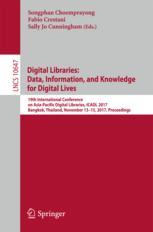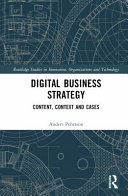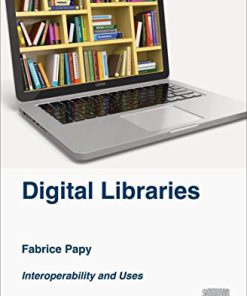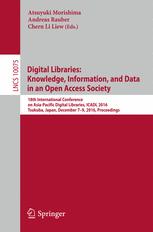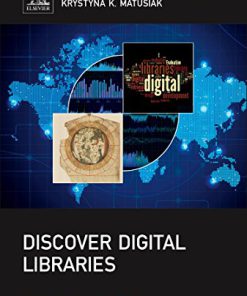Digital information strategies from applications and content to libraries and people 1st Edition by David Baker, Wendy Evans ISBN 0081002513 9780081002513
$50.00 Original price was: $50.00.$25.00Current price is: $25.00.
Digital information strategies from applications and content to libraries and people 1st Edition by David Baker, Wendy Evans – Ebook PDF Instant Download/Delivery: 0081002513, 978-0081002513
Full download Digital information strategies from applications and content to libraries and people 1st Edition after payment

Product details:
ISBN 10: 0081002513
ISBN 13: 978-0081002513
Author: David Baker, Wendy Evans
Digital Information Strategies: From Applications and Content to Libraries and People provides a summary and summation of key themes, advances, and trends in all aspects of digital information at the present time.
This helpful resource explores the impact of developing technologies on the information world. Written from an international perspective, the book emphasizes key current topics and future developments. The publication is based on a dynamic set of contents that respond to, and anticipate, what is happening―and what may well happen―in the field of digital information.
- Presents a comprehensive overview of the major aspects of contemporary digital information provision
- Serves as a useful reference work for the subject area
- Features input written from an international perspective
- Explores the impact of developing technologies on the information world, emphasizing key, current topics and future developments
Digital information strategies from applications and content to libraries and people 1st Table of contents:
Chapter 1. Digital Information Strategies
- Introduction
- The Next Five Years
- Enduring Elements
- Necessary Change
- Key Drivers
- Technology
- Key User Needs
- Future Physical Space
- Future Skills Needs of Library and Information Services Professionals
- Conclusion: Evolution and Revolution
- Notes
- References
Part I: Strategy
Chapter 2. Strategic Futures for Digital Information Services
- Introduction
- A Digital Library is Not a Library
- Challenges to Progress
- The Future is Not What it Used to Be
- The View Across Three Horizons
- Conclusions: To Lead or Be Led?
- Notes
- References
Part II: Research
Chapter 3. Great Libraries? Good Libraries? Digital Collection Development and What it Means for Our Great Research Collections
- Introduction: What Makes a Great Research Library?
- Building Digital Collections
- Commercially Published Research Publications – Moving from Physical to Digital
- Connecting Legal Deposit – The Evolution to Digital Collecting
- New Born-Digital – Collecting the Web
- Unique and Special Collections – Born-Digital Heritage
- Rediscovering Legacy Collections – Digitisation of Historic Analogue Collections
- Conclusion
- Notes
- References
Chapter 4. Research Information Management
- Introduction
- Drivers
- Responses
- Next Steps
- Conclusion
- Notes
- References
Chapter 5. Digital Research Data: Where are we Now?
- Introduction
- Data Sharing
- What is Data and What Constitutes Big Data?
- Data Quality
- Ethical Considerations in Using Big Data
- Data Management and Data Curation Today
- Data Citation
- Research Data and the Library
- Data-Related Literacies: In Search of a Name
- Conclusion
- Notes
- References
- Selected Online Resources
Part III: Linked Data
Chapter 6. From Linked Open Data to Linked Open Knowledge
- Introduction
- From Cataloguing to Catalinking: Re-Imagining Annotation
- Controlled Vocabularies: Trenches to Triples
- Visualisation: Linked Data in Archive Maps
- Lessons Learned
- Notes
Part IV: Technology
Chapter 7. Transforming Libraries from Physical to Virtual
- Introduction: Digital Revolutions
- Web Presence
- Social Media
- Mobile Technology
- Digital Collections
- Digital Libraries
- Digital Reference
- Virtual Instruction
- Digital Alerts
- Virtual Exhibitions
- Conclusion
- Notes
- References
Chapter 8. People’s Technology: Where is the Line?
- Introduction
- Conception of Technology
- Pattern of Technology Use
- How Libraries in Nigeria are Coping
- Challenges to Technology Deployment
- Conclusion
- Notes
- References
Chapter 9. Swedish Local Politicians’ Views on Public Library Digital Services
- Introduction
- Some Background Information
- Collecting the Empirical Data
- Local Politicians’ Views on Public Library Digital Services
- Discussion
- Some Conclusions
- Note
- References
Chapter 10. Conceptualising the Library Collection for the Digital World
- Introduction
- Defining Collection
- Concepts and Models
- Alternative Terminology
- Searching, Sharing … Collecting?
- A New Model of Collection?
- Facilitating Dynamic Collection? Digital Technology for Collection Management
- Conclusion
- Notes
- Acknowledgement
- References
Chapter 11. From Clients to Participants – How Information Technology Impacts Relationships Between Professionals and Users
- Introduction
- 1972 to 1993/4
- Professional Reactions
- 1994 Onwards
- Reactions of the Profession
- Discussion
- References
Chapter 12. ‘Where’ Matters: Keeping Apace with Geo-Ubiquity in a Digital World
- Introduction
- Initial Perspectives of Our Changing Digital World
- ‘Digital Divide’ – Connectivity and Growing ‘Data-Centricity’
- Digital Infrastructures
- Digital Information and Location Geo-Ubiquity
- Perspectives on the Impact of ‘Digital’ Trends in the Geospatial Domain
- Growing Access to Geospatial Data and Digital Mapping
- The Growing Importance of Big and Small Data
- Data Analytics, Visualisation and Dashboards for Business Intelligence
- Citizen Science and Crowdsourcing (Volunteered Geographic Information)
- Mobile and Social Media
- Augmented Reality
- The Internet of Things
- Personal Cloud
- Conclusion: Future Developments and Strategic Trends
- Notes
- References
Chapter 13. Digital Data and the City: An Exploration of the Building Blocks of a Smart City Architecture
- Introduction
- Dreaming of Smart Cities
- Utopia is Becoming Reality
- Building Blocks of the Smart City
- Information Management: Protecting Data ‘with Your Life’
- Information Management: Information Value Chain
- Conclusion
- References
Part V: The Internet and Users/User Behaviour
Chapter 14. Thriving in the Digital Age: Conquests, Challenges, and Thoughts on School Libraries
- Introduction
- General Characteristics of Young People
- The Use of Digital Tools in School Libraries
- The Challenges of Using Digital Tools
- The Common Core Standards
- E-Book Concerns
- Getting Past the Filters
- Remaining Viable
- The Development of Literacy Skills
- Forming Community Partnerships
- Being Transformational Leaders
- Conclusion
- Notes
- References
Chapter 15. Knowing Your Users, Discovering Your Library: An Overview of the Characteristics of User Generations
- Introduction
- Generations of Users: Definitions
- Generations of Users: Characteristics and Factors Informing Characteristics
- Generations of Users: Impact on Libraries
- Conclusion
- References
Part VI: Digital Media
Chapter 16. Presence, Permeability and Playfulness: Future Library Architecture in the Digital Era
- Introduction
- The Presence of Libraries
- Physical and Conceptual Permeability
- Spaces of Playfulness
- Concluding Remarks – A Manifesto for Future Library Architecture
- Acknowledgements
- References
Part VII: Collaboration
Chapter 17. Strategic Futures: Partnering for Student Success
- Introduction
- Developing Services
- Developing Partnerships
- Virtual Services
- Quiet Space
- Access
- Flexible Planning, Flexible Space
- Marketing
- Data Measurements
People also search for Digital information strategies from applications and content to libraries and people 1st:
digital futures strategies for the information age
what should a digital strategy include
digital transformation strategies business & information systems engineering
what is digital business strategy
what strategies will keep your personal & digital information safe
Tags:
David Baker,Wendy Evans,Digital information,strategies,applications,content,libraries,people 1st
You may also like…
Politics & Philosophy - Social Sciences
Digital Libraries and Crowdsourcing 1st Edition Mathieu Andro
Business & Economics - E-Commerce
Digital Business Strategy : Content, Context and Cases 1st Edition Pehrsson
Computers - Networking
Digital libraries : interoperability and uses 1st Edition Papy
Engineering - Mechanical Engineering & Dynamics
Computers - Networking
Discover Digital Libraries. Theory and Practice 1st Edition Iris Xie




